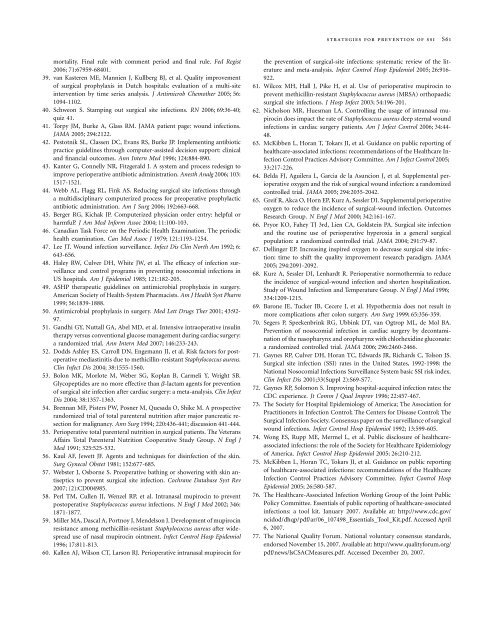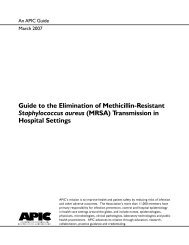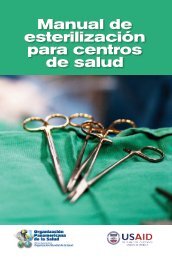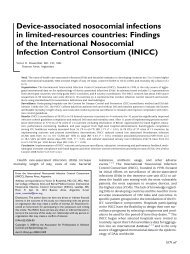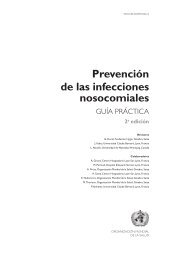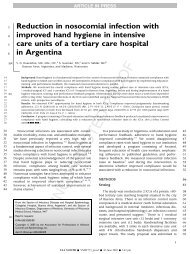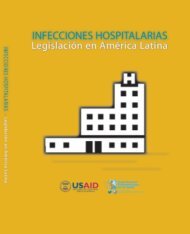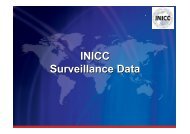Strategies to Prevent Surgical Site Infections in Acute Care Hospitals
Strategies to Prevent Surgical Site Infections in Acute Care Hospitals
Strategies to Prevent Surgical Site Infections in Acute Care Hospitals
Create successful ePaper yourself
Turn your PDF publications into a flip-book with our unique Google optimized e-Paper software.
strategies for prevention of ssiS61mortality. F<strong>in</strong>al rule with comment period and f<strong>in</strong>al rule. Fed Regist2006; 71:67959-68401.39. van Kasteren ME, Mannien J, Kullberg BJ, et al. Quality improvemen<strong>to</strong>f surgical prophylaxis <strong>in</strong> Dutch hospitals: evaluation of a multi-site<strong>in</strong>tervention by time series analysis. J Antimicrob Chemother 2005; 56:1094-1102.40. Schweon S. Stamp<strong>in</strong>g out surgical site <strong>in</strong>fections. RN 2006; 69:36-40;quiz 41.41. Torpy JM, Burke A, Glass RM. JAMA patient page: wound <strong>in</strong>fections.JAMA 2005; 294:2122.42. Pes<strong>to</strong>tnik SL, Classen DC, Evans RS, Burke JP. Implement<strong>in</strong>g antibioticpractice guidel<strong>in</strong>es through computer-assisted decision support: cl<strong>in</strong>icaland f<strong>in</strong>ancial outcomes. Ann Intern Med 1996; 124:884-890.43. Kanter G, Connelly NR, Fitzgerald J. A system and process redesign <strong>to</strong>improve perioperative antibiotic adm<strong>in</strong>istration. Anesth Analg 2006; 103:1517-1521.44. Webb AL, Flagg RL, F<strong>in</strong>k AS. Reduc<strong>in</strong>g surgical site <strong>in</strong>fections througha multidiscipl<strong>in</strong>ary computerized process for preoperative prophylacticantibiotic adm<strong>in</strong>istration. Am J Surg 2006; 192:663-668.45. Berger RG, Kichak JP. Computerized physician order entry: helpful orharmful? J Am Med Inform Assoc 2004; 11:100-103.46. Canadian Task Force on the Periodic Health Exam<strong>in</strong>ation. The periodichealth exam<strong>in</strong>ation. Can Med Assoc J 1979; 121:1193-1254.47. Lee JT. Wound <strong>in</strong>fection surveillance. Infect Dis Cl<strong>in</strong> North Am 1992; 6:643-656.48. Haley RW, Culver DH, White JW, et al. The efficacy of <strong>in</strong>fection surveillanceand control programs <strong>in</strong> prevent<strong>in</strong>g nosocomial <strong>in</strong>fections <strong>in</strong>US hospitals. Am J Epidemiol 1985; 121:182-205.49. ASHP therapeutic guidel<strong>in</strong>es on antimicrobial prophylaxis <strong>in</strong> surgery.American Society of Health-System Pharmacists. Am J Health Syst Pharm1999; 56:1839-1888.50. Antimicrobial prophylaxis <strong>in</strong> surgery. Med Lett Drugs Ther 2001; 43:92-97.51. Gandhi GY, Nuttall GA, Abel MD, et al. Intensive <strong>in</strong>traoperative <strong>in</strong>sul<strong>in</strong>therapy versus conventional glucose management dur<strong>in</strong>g cardiac surgery:a randomized trial. Ann Intern Med 2007; 146:233-243.52. Dodds Ashley ES, Carroll DN, Engemann JJ, et al. Risk fac<strong>to</strong>rs for pos<strong>to</strong>perativemediast<strong>in</strong>itis due <strong>to</strong> methicill<strong>in</strong>-resistant Staphylococcus aureus.Cl<strong>in</strong> Infect Dis 2004; 38:1555-1560.53. Bolon MK, Morlote M, Weber SG, Koplan B, Carmeli Y, Wright SB.Glycopeptides are no more effective than b-lactam agents for preventionof surgical site <strong>in</strong>fection after cardiac surgery: a meta-analysis. Cl<strong>in</strong> InfectDis 2004; 38:1357-1363.54. Brennan MF, Pisters PW, Posner M, Quesada O, Shike M. A prospectiverandomized trial of <strong>to</strong>tal parenteral nutrition after major pancreatic resectionfor malignancy. Ann Surg 1994; 220:436-441; discussion 441-444.55. Perioperative <strong>to</strong>tal parenteral nutrition <strong>in</strong> surgical patients. The VeteransAffairs Total Parenteral Nutrition Cooperative Study Group. NEnglJMed 1991; 325:525-532.56. Kaul AF, Jewett JF. Agents and techniques for dis<strong>in</strong>fection of the sk<strong>in</strong>.Surg Gynecol Obstet 1981; 152:677-685.57. Webster J, Osborne S. Preoperative bath<strong>in</strong>g or shower<strong>in</strong>g with sk<strong>in</strong> antiseptics<strong>to</strong> prevent surgical site <strong>in</strong>fection. Cochrane Database Syst Rev2007; (2):CD004985.58. Perl TM, Cullen JJ, Wenzel RP, et al. Intranasal mupiroc<strong>in</strong> <strong>to</strong> preventpos<strong>to</strong>perative Staphylococcus aureus <strong>in</strong>fections. NEnglJMed2002; 346:1871-1877.59. Miller MA, Dascal A, Portnoy J, Mendelson J. Development of mupiroc<strong>in</strong>resistance among methicill<strong>in</strong>-resistant Staphylococcus aureus after widespreaduse of nasal mupiroc<strong>in</strong> o<strong>in</strong>tment. Infect Control Hosp Epidemiol1996; 17:811-813.60. Kallen AJ, Wilson CT, Larson RJ. Perioperative <strong>in</strong>tranasal mupiroc<strong>in</strong> forthe prevention of surgical-site <strong>in</strong>fections: systematic review of the literatureand meta-analysis. Infect Control Hosp Epidemiol 2005; 26:916-922.61. Wilcox MH, Hall J, Pike H, et al. Use of perioperative mupiroc<strong>in</strong> <strong>to</strong>prevent methicill<strong>in</strong>-resistant Staphylococcus aureus (MRSA) orthopaedicsurgical site <strong>in</strong>fections. J Hosp Infect 2003; 54:196-201.62. Nicholson MR, Huesman LA. Controll<strong>in</strong>g the usage of <strong>in</strong>tranasal mupiroc<strong>in</strong>does impact the rate of Staphylococcus aureus deep sternal wound<strong>in</strong>fections <strong>in</strong> cardiac surgery patients. Am J Infect Control 2006; 34:44-48.63. McKibben L, Horan T, Tokars JI, et al. Guidance on public report<strong>in</strong>g ofhealthcare-associated <strong>in</strong>fections: recommendations of the Healthcare InfectionControl Practices Advisory Committee. Am J Infect Control 2005;33:217-226.64. Belda FJ, Aguilera L, Garcia de la Asuncion J, et al. Supplemental perioperativeoxygen and the risk of surgical wound <strong>in</strong>fection: a randomizedcontrolled trial. JAMA 2005; 294:2035-2042.65. Greif R, Akca O, Horn EP, Kurz A, Sessler DI. Supplemental perioperativeoxygen <strong>to</strong> reduce the <strong>in</strong>cidence of surgical-wound <strong>in</strong>fection. OutcomesResearch Group. N Engl J Med 2000; 342:161-167.66. Pryor KO, Fahey TJ 3rd, Lien CA, Goldste<strong>in</strong> PA. <strong>Surgical</strong> site <strong>in</strong>fectionand the rout<strong>in</strong>e use of perioperative hyperoxia <strong>in</strong> a general surgicalpopulation: a randomized controlled trial. JAMA 2004; 291:79-87.67. Dell<strong>in</strong>ger EP. Increas<strong>in</strong>g <strong>in</strong>spired oxygen <strong>to</strong> decrease surgical site <strong>in</strong>fection:time <strong>to</strong> shift the quality improvement research paradigm. JAMA2005; 294:2091-2092.68. Kurz A, Sessler DI, Lenhardt R. Perioperative normothermia <strong>to</strong> reducethe <strong>in</strong>cidence of surgical-wound <strong>in</strong>fection and shorten hospitalization.Study of Wound Infection and Temperature Group. N Engl J Med 1996;334:1209-1215.69. Barone JE, Tucker JB, Cecere J, et al. Hypothermia does not result <strong>in</strong>more complications after colon surgery. Am Surg 1999; 65:356-359.70. Segers P, Speekenbr<strong>in</strong>k RG, Ubb<strong>in</strong>k DT, van Ogtrop ML, de Mol BA.<strong>Prevent</strong>ion of nosocomial <strong>in</strong>fection <strong>in</strong> cardiac surgery by decontam<strong>in</strong>ationof the nasopharynx and oropharynx with chlorhexid<strong>in</strong>e gluconate:a randomized controlled trial. JAMA 2006; 296:2460-2466.71. Gaynes RP, Culver DH, Horan TC, Edwards JR, Richards C, Tolson JS.<strong>Surgical</strong> site <strong>in</strong>fection (SSI) rates <strong>in</strong> the United States, 1992-1998: theNational Nosocomial <strong>Infections</strong> Surveillance System basic SSI risk <strong>in</strong>dex.Cl<strong>in</strong> Infect Dis 2001;33(Suppl 2):S69-S77.72. Gaynes RP, Solomon S. Improv<strong>in</strong>g hospital-acquired <strong>in</strong>fection rates: theCDC experience. Jt Comm J Qual Improv 1996; 22:457-467.73. The Society for Hospital Epidemiology of America; The Association forPractitioners <strong>in</strong> Infection Control; The Centers for Disease Control; The<strong>Surgical</strong> Infection Society. Consensus paper on the surveillance of surgicalwound <strong>in</strong>fections. Infect Control Hosp Epidemiol 1992; 13:599-605.74. Wong ES, Rupp ME, Mermel L, et al. Public disclosure of healthcareassociated<strong>in</strong>fections: the role of the Society for Healthcare Epidemiologyof America. Infect Control Hosp Epidemiol 2005; 26:210-212.75. McKibben L, Horan TC, Tokars JI, et al. Guidance on public report<strong>in</strong>gof healthcare-associated <strong>in</strong>fections: recommendations of the HealthcareInfection Control Practices Advisory Committee. Infect Control HospEpidemiol 2005; 26:580-587.76. The Healthcare-Associated Infection Work<strong>in</strong>g Group of the Jo<strong>in</strong>t PublicPolicy Committee. Essentials of public report<strong>in</strong>g of healthcare-associated<strong>in</strong>fections: a <strong>to</strong>ol kit. January 2007. Available at: http://www.cdc.gov/ncidod/dhqp/pdf/ar/06_107498_Essentials_Tool_Kit.pdf. Accessed April6, 2007.77. The National Quality Forum. National voluntary consensus standards,endorsed November 15, 2007. Available at: http://www.qualityforum.org/pdf/news/lsCSACMeasures.pdf. Accessed December 20, 2007.


